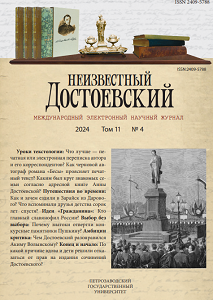«…Но Зарайск, разумеется, и богаче и лучше» (город детства в жизни и творчестве Ф. М. Достоевского)
“…But Zaraysk is Certainly Richer and Better” (Town of Childhood in the Life and Work of F. M. Dostoevsky)
Author(s): Kirill V. KondratievSubject(s): Cultural history, Russian Literature, 19th Century
Published by: Петрозаводский государственный университет
Keywords: Fyodor Dostoevsky; biography; Darovoe Village; Zaraysk Town; Astrakhan tract; novel; Bakhrushins; Kumanins; Papyshevs; prototypes; provincial theater; Old Believers;
Summary/Abstract: The historical realities of the town of Zaraysk, Ryazan province, which is associated with the childhood and adolescence of F. M. Dostoevsky, have not received due attention from researchers to date. The article, based on a large array of previously unknown archival documents, provides a general description of the town’s socio-economic development in the 1830s, which allows to clarify a number of facts of the writer’s early biography and explain his enthusiastic appraisal of Zaraysk in personal correspondence in 1868. The author of the article puts forward several hypotheses regarding the presence of the Zaraysk context in the works of F. M. Dostoevsky. The first hypothesis correlates the cultural landscape of the western outskirts of Zaraysk with the description of the childhood town in Raskolnikov’s first dream. In the second, a version is set forth about the possible Zaraysk roots of the literary toponym Skotoprigon’evsk. Thanks to archival finds, the history of the Bakhrushin merchant family from Zaraysk was analyzed in detail, and their connection with the Kumanin family, which is related to the writer, was established. This ultimately allowed us to put forward an assumption about the prototypes of episodic characters in the novels “Crime and Punishment” (merchant Afanasy Ivanovich Vakhrushin) and “The Idiot” (merchant Papushin). Special attention in the context of the literary biography of the dyer Mikolka in the novel “Crime and Punishment” is paid to documentary evidence of the spread of Old Believers and mystical sectarianism in the Zaraysk district. For the first time, the history of theatrical life in Zaraysk is considered, also revealing a connection with Dostoevsky’s work. A report on the state of the town of Zaraysk for 1836 and a petition from the mayor of Zaraysk F. E. Tepitsyn for the preservation of the Astrakhan tract are published for the first time in the Appendices to the article. The documents contain important information for understanding the socio-economic, historical and cultural environment surrounding the future writer here.
Journal: Неизвестный Достоевский
- Issue Year: 11/2024
- Issue No: 4
- Page Range: 173-226
- Page Count: 54
- Language: Russian

